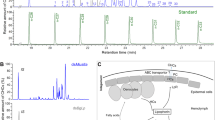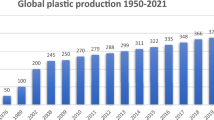Abstract
Laboratory-reared males of the cactophilic Drosophila pachea exhibit a spontaneous and sex-specific suppression of alcohol dehydrogenase (ADH) activity within 4 days after eclosion. A lack of ADH activity also is usually seen in wild-caught males, although relatively high activity is always seen in female flies. In the present study we examined the effectiveness of different alcohols and related compounds, including several found naturally in necroses of the host cactus, to induce suppressed ADH activity in wild males of D. pachea and to serve as enzyme substrates. The primary alcohols (methanol, ethanol, 1-propanol, 1-butanol, and 1-pentanol), and the secondary alcohols (2-propanol and 2-butanol), each induced activity after 24 h exposure, although to different degrees. 1,2-Propanediol was usually effective as an inducer, but 2,3-butanediol usually was ineffective. Little or no induction was seen with 1-octanol, 2-pentanol, 3-methyl-1-butanol, 3-hydroxy-2-butanone, or acetaldehyde. Although the compounds tested varied in their ability to function as ADH substrates, methanol was the only alcohol that showed no activity staining. Ethanol induction of ADH activity was apparent after 3–6 h exposure and induced activity decreased dramatically within 1 week of flies being placed in an alcohol-free environment. Ethanol exposure did not induce ADH in adult female D. pachea, or in adult males and females of D. acutilabella in which control males show reduced ADH activity compared to females. The implications of the loss of ADH activity in adult males of D. pachea, as they relate to feeding ecology and fitness, are discussed.
Similar content being viewed by others
References
Benach, J., Atrian, S., Ladenstein, R., & Gonzàlez-Duarte, R. (2001). Genesis of Drosophila ADH: The shaping of the enzymatic activity from a SDR ancestor. Chem. Biol. Interact. 130–132:405–415.
Chambers, G. K., McDonald, J. F., McElfresh, M., & Ayala, F. J. (1978). Alcohol-oxidizing enzymes in 13 Drosophila species. Biochem. Genet. 16:757–767.
Colón-Parrilla, W. V., & Pérez-Chiesa, I. (1999). Ethanol tolerance and alcohol dehydrogenase (ADH; EC 1.1.1.1) activity in species of the cardini group of Drosophila. Biochem. Genet. 37:95–107.
Danielsson, O., Atrian, S., Luque, T., Hjelmqvist, L., & Gonzàlez-Duarte, R. (1994). Fundamental molecular differences between alcohol dehydrogenase classes. Proc. Natl. Acad. Sci. U.S.A. 91:4980–4984.
Etges, W. J., & Klassen, C. S. (1989). Influences of atmospheric ethanol on adult Drosophila mojavensis: Altered metabolic rates and increases in fitness among populations. Physiol. Zool. 62:170–193.
Fogleman, J. C., & Abril, J. R. (1990). Ecological and evolutionary importance of host plant chemistry. In Barker, J. S. F., Starmer, W. T., & MacIntyre, R. J. (eds.), Ecological and Evolutionary Genetics of Drosophila, Plenum, New York, pp. 121–143.
Fogleman, J. C., & Heed, W. B. (1989). Columnar cacti and desert Drosophila: The chemistry of host plant specificity. In Schmidt, J. (ed.), Special Biotic Relationships in the Arid Southwest, University of New Mexico Press, Albuquerque, pp. 1–24.
Fogleman, J. C., Duperret, S. M., & Kircher, H. W. (1986). The role of phytosterols in host plant utilization by cactophilic Drosophila. Lipids 21:92–96.
Geer, B. W., McKechnie, S. W., Bentley, M. M., Oakeshott, J. G., Quinn, E. M., & Langevin, M. L. (1988). Induction of alcohol dehydrogenase by ethanol in Drosophila melanogaster. J. Nutr. 118:398–407.
Hebert, P. D. N., & Beaton, M. J. (1989). Methodologies for Allozyme Analysis Using Cellulose Acetate Electrophoresis, Helena Laboratories, Beaumont, TX.
Heed, W. B. (1978). Ecology and genetics of Sonoran Desert Drosophila. In Brussard, P. F. (ed.), Ecological Genetics: The Interface, Springer-Verlag, New York, pp. 109–126.
Heed, W. B., & Kircher, H. W. (1965). Unique sterol in the ecology and nutrition of Drosophila pachea. Science 149:758–761.
Heinstra, P. W. H., Geer, B. W., Seykens, D., & Langevin, M. (1989). The metabolism of ethanol-derived acetaldehyde by alcohol dehydrogenase (EC 1.1.1.1) and aldehyde dehydrogenase (EC 1.2.1.3) in Drosophila melanogaster larvae. Biochem. J. 259:791–797.
Kapoun, A. M., Geer, B. W., Heinstra, P. W. H., Corbin, V., & McKechnie, S. W. (1990). Molecular control of the induction of alcohol dehydrogenase by ethanol in Drosophila melanogaster larvae. Genetics 124:881–888.
Kerver, J. W. M., & Van Delden, W. (1985). Development of tolerance to ethanol in relation to the alcohol dehydrogenase locus in Drosophila melanogaster. 1. Adult and egg-to-adult survival in relation to ADH activity. Heredity 55:355–367.
Markow, T. A., Anwar, S., & Pfeiler, E. (2000). Stable isotope ratios of carbon and nitrogen in natural populations of Drosophila species and their hosts. Funct. Ecol. 14:261–266.
Parsons, P. A. (1981). Longevity of cosmopolitan and native Australian Drosophila in ethanol atmospheres. Aust. J. Zool. 29:33–39.
Pecsenye, K., Bokor, K., Lefkovitch, L. P., Giles, B. E., & Saura, A. (1997). Enzymatic responses of Drosophila melanogaster to long-and short-term exposures to ethanol. Mol. Gen. Genet. 255:258–268.
Pecsenye, K., & Saura, A. (1998). Interaction between the Adh and Odh loci in response to ethanol in Drosophila melanogaster. Biochem. Genet. 36:147–170.
Pfeiler, E., & Markow, T. A. (2001). Loss of expression of alcohol dehydrogenase in adult males of Drosophila pachea. Biochem. Genet. 39:139–144.
Pitnick, S. (1996). Investment in testes and the cost of making long sperm in Drosophila. Am. Nat. 148:57–80.
Pitnick, S., Markow, T. A., & Spicer, G. S. (1995). Delayed male maturity is a cost of producing large sperm in Drosophila. Proc. Natl. Acad. Sci. U.S.A. 92:10614–10618.
Schwartz, M., O'Donnell, J., & Sofer, W. (1979). Origin of the multiple forms of alcohol dehydrogenase from Drosophila melanogaster. Arch. Biochem. Biophys. 194:365–378.
Schwartz, M., & Sofer, W. (1976). Diet-induced alterations in distribution of multiple forms of alcohol dehydrogenase in Drosophila. Nature 263:129–131.
Starmer, W. T., Heed, W. B., & Rockwood-Sluss, E. S. (1977). Extension of longevity in Drosophila mojavensis by environmental ethanol: Differences between subraces. Proc. Natl. Acad. Sci. U.S.A. 74:387–391.
Van Herrewege, J, and David, J. R. (1980). Alcohol tolerance and alcohol utilization in Drosophila: Partial independence of two adaptive traits. Heredity 44:229–235.
Winberg, J.-O., Thatcher, D. R., & McKinley-McKee, J. S. (1982). Alcohol dehydrogenase from the fruitfly Drosophila melanogaster. Substrate specificity of the alleloenzymes AdhS and AdhUF. Biochim. Biophys. Acta 704:7–16.
Rights and permissions
About this article
Cite this article
Pfeiler, E., Markow, T.A. Induction of Suppressed ADH Activity in Drosophila pachea Exposed to Different Alcohols. Biochem Genet 41, 413–426 (2003). https://doi.org/10.1023/B:BIGI.0000007776.65086.74
Issue Date:
DOI: https://doi.org/10.1023/B:BIGI.0000007776.65086.74




